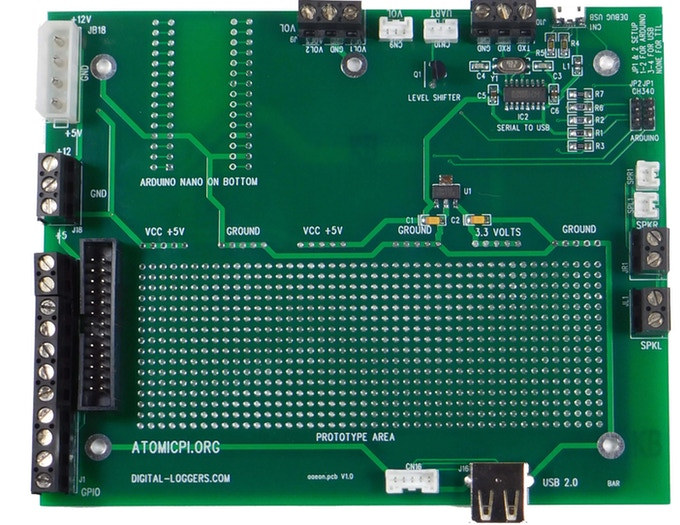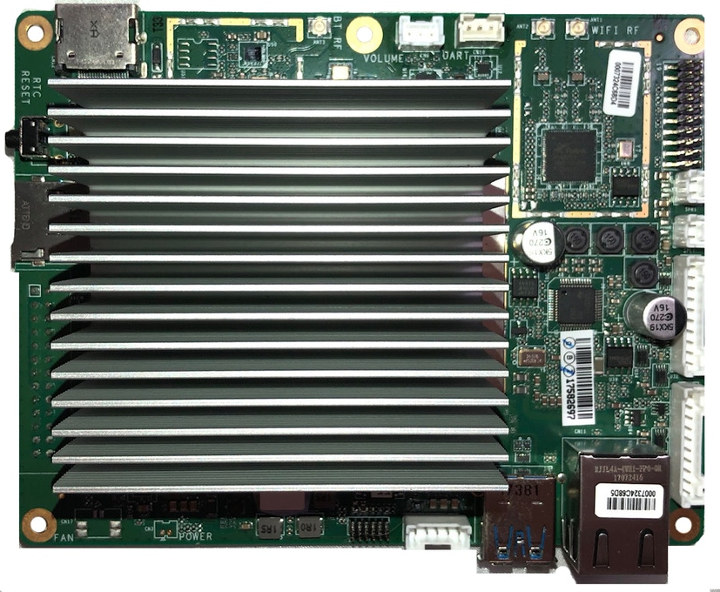Following Raspberry Pi form factor, AAEON Up Board powered by an Intel Atom x5-Z8300 processor launched in 2015 for 89 Euros and up via a crowdfunding campaign. Since then, the company switched to Atom x5-Z8350, and now offers for the board for $99 US and up, with for example the 2GB RAM / 16GB flash version going for $109 excluding taxes and shipping.
I’m mentioning this board, as there’s now a crowdfunding campaign for a larger board with similar specifications (x5-Z8350, 2GB RAM, 16GB flash) called ATOMIC Pi, and being offered for just $34 plus shipping by “Team IoT”. This looks too good to be true, but that’s intriguing so let’s have closer look.
- SoC – Intel Atom x5-Z8350 quad core processor @ up to 1.92GHz with Intel HD graphics
- System Memory – 2GB DDR3L-1600
- Storage – 16GB eMMC flash, slot for SD expansion up to 256GB
- Video Output – HDMI port
- Connectivity
- Gigabit Ethernet via Realtek RTL8111G transceiver
- Dual band 802.11b/g/n/ac WiFi 5 via RT5572 with IPX connectors on board
- Bluetooth 4.0 via CSR8510
- USB – USB 3.0 and USB 2.0 ports
- Sensor – 9-axis inertial navigation sensor with compass (BNO055)
- Expansion – JST style connectors and a 26-pin header for power & GPIO
- Debugging – TTL serial debug and expansion serial ports up to 3.6Mbps
- Misc – Real time clock & battery
- Power Supply – 5V/4A recommended. 4-15 watts typ. power consumption
- Dimensions – 130 x 100 x 50 mm
The board will come pre-loaded with Linux, but Windows 10 64-bit is also supported. The datasheet and a quick start guide will be available on AtomicPi.org which now redirects to Digital Loggers website… The short video below shows the ATOMIC Pi works, and runs Kubuntu.
If you pay close attention to the first photo, there’s no power barrel connector, so you’d need to need to wire the power connection yourself, unless you purchase the kit with the breakout shield – also used in the video – which adds screw terminals, a 12V header, and a prototyping area.
 The total cost for Atomic Pi board plus the breakout board is still only $49 plus shipping, which adds $11 to the United States for a total of $60. What if you live outside of the US? Sorry they won’t ship, so your only option would be to go with a US forwarder. What even more interesting is that AAEON, UP board maker, is one of their manufacturing partners along with Qualtech Circuits, and PC Way. Team IoT has managed three earlier KickStarter campaigns in the past, and they did ship to backers. Atomic Pi board appears to be ready, as shipping is scheduled for the end of January 2019.
The total cost for Atomic Pi board plus the breakout board is still only $49 plus shipping, which adds $11 to the United States for a total of $60. What if you live outside of the US? Sorry they won’t ship, so your only option would be to go with a US forwarder. What even more interesting is that AAEON, UP board maker, is one of their manufacturing partners along with Qualtech Circuits, and PC Way. Team IoT has managed three earlier KickStarter campaigns in the past, and they did ship to backers. Atomic Pi board appears to be ready, as shipping is scheduled for the end of January 2019.
Thanks to PuceBaboon for the tip.

Jean-Luc started CNX Software in 2010 as a part-time endeavor, before quitting his job as a software engineering manager, and starting to write daily news, and reviews full time later in 2011.
Support CNX Software! Donate via cryptocurrencies, become a Patron on Patreon, or purchase goods on Amazon or Aliexpress





